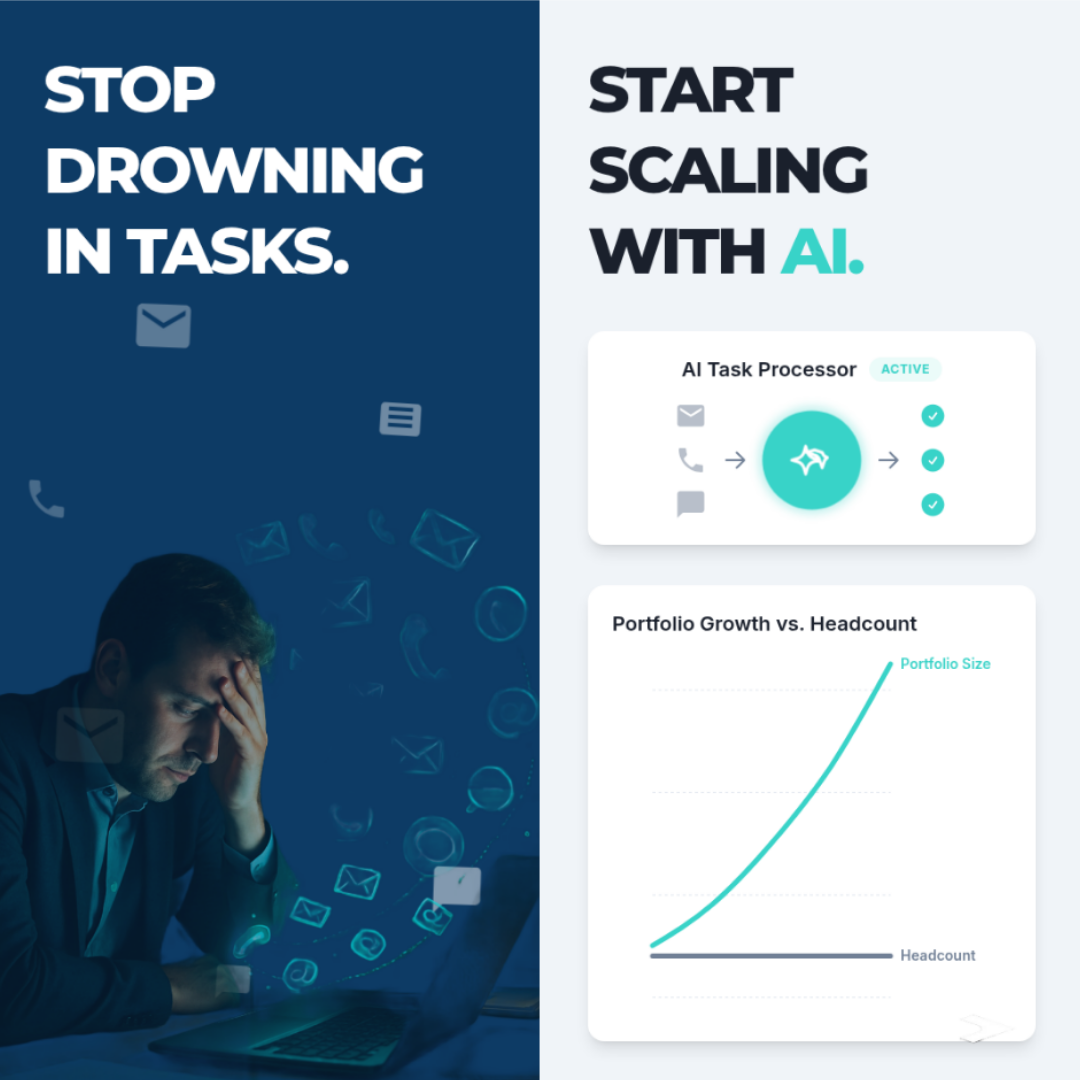The Property Manager's Guide to AI Automation: How to Scale Operations Without Scaling Headcount

I used to manage a $19 million residential portfolio. Every morning started the same way: drowning in messages.
Tenant complaints about a broken AC unit. Prospective renters asking about pet policies for the third time that week. Maintenance vendors needing access codes. Overseas support teams needing clarification on a work order that should have been resolved days ago.
I wasn't managing properties. I was managing chaos.
And when I finally sat down to analyze where all our time was going, the answer was painfully clear: 65% of our operational workload was answering the same 20 questions over and over again.
If you're running a property management operation today, you already know this pain. Your best people are buried in repetitive communication instead of solving the complex problems that actually move the needle. You're losing leads because you can't respond fast enough. Your team is burning out. And the thought of scaling your portfolio feels impossible because it means scaling your support team at the same rate.
But here's what I learned after living this problem, then building an AI company to solve it: You don't need more people to scale. You need smarter systems.
This guide will show you exactly how to use AI automation to scale your property management operations without adding headcount—based on real data from operators who've done it.

The Real Cost of Manual Operations
Before we talk about solutions, let's talk about what the current model is actually costing you.
Most property managers are stuck in what I call the "linear scaling trap." It looks like this:
- You manage 100 units with a team of 3 people
- You grow to 200 units, so you hire 3 more people
- You grow to 400 units, you need 6 more people
- Revenue grows linearly. Costs grow linearly. Profit margins stay flat.
But the hidden costs are even worse than the obvious ones:
Training Time: Every new support agent takes 3-4 weeks to get up to speed on your portfolio. During that time, they're making mistakes, creating more work for your senior team, and providing inconsistent tenant experiences.
Turnover Costs: Support roles have notoriously high turnover. When someone leaves, you're not just replacing a person—you're losing institutional knowledge and starting the training cycle all over again.
Revenue Leakage: Every inquiry that goes unanswered for more than 2 hours is a potential lost lease. In competitive markets, response time is everything. One operator told me, "We lose deals not because our properties aren't good enough, but because we can't get back to people fast enough."
Quality Inconsistency: With a team of 10 people answering questions across different channels, you're going to get 10 different answers. One person might quote 50 for a pet deposit. Another might say 50 for a pet deposit. Another might say 75. Your brand suffers, and so does your NPS score.
The math is brutal. Let's say you're managing 350 units with a support team of 5 people at an average cost of 45,000 per person(salary+benefits+overhead).That′s 45,000 per person(salary+benefits+overhead). That′s 225,000 in annual support costs, or $643 per unit per year.
What if I told you there's a way to cut that cost by 60% while simultaneously improving response times and guest satisfaction scores?
The AI Automation Framework: A Three-Layer System
After working with hundreds of property managers, I've identified a framework that works regardless of portfolio size or asset class. I call it the Three-Layer Automation System.
Layer 1: Intelligent Triage (Automate 40-50% of Volume)
The first layer handles the highest-volume, lowest-complexity communications. These are the questions your team answers on autopilot:
- "What's the WiFi password?"
- "When is trash day?"
- "How do I access the parking garage?"
- "What's your pet policy?"
- "Is the unit available for these dates?"
An AI agent with access to your property documentation can handle these instantly, 24/7, across every communication channel—text, email, voice calls, your tenant portal.
The key insight: You don't need a human to answer questions that have a definitive, documented answer. You need a human for judgment calls, empathy, and complex problem-solving.
When we deployed this layer for a 20-room hotel owner, they reduced their guest support line item by $3,200 per month. The AI handled the repetitive stuff. The owner handled the meaningful stuff.
Layer 2: Context-Aware Automation (Automate an Additional 15-20% of Volume)
The second layer handles communications that require context but not judgment. These are interactions where the AI needs to understand:
- Who is this person? (tenant, prospective renter, owner)
- What property are they asking about?
- What's the current status? (application pending, lease signed, move-in scheduled)
- What are the relevant rules, rates, or policies?
For example, a prospective renter asks: "I have a 60-pound dog. Can I still apply?"
A basic chatbot would give a generic answer. A context-aware AI agent knows:
- The specific pet policy for that property
- Whether there are breed restrictions
- The exact pet deposit and monthly pet rent
- That this person is a lead, not a current tenant
- That the unit they inquired about is still available
The AI can respond with a complete, accurate answer and even include an application link. No human required.
Layer 3: Human-in-the-Loop (The Critical 30-35%)
The third layer is where humans still win. These are communications that require empathy, de-escalation, or strategic decision-making:
- An angry tenant whose AC has been broken for three days
- A complex maintenance issue that requires vendor coordination
- A lease violation that needs careful handling
- A unique situation with no documented precedent
Here's the critical part: Your AI system should know when to escalate to a human. The goal isn't to automate everything. The goal is to automate the noise so your best people can focus on the signal.
When a message gets escalated, your human support team should have full context: the entire conversation history, the tenant's profile, relevant property documentation, and a suggested response drafted by the AI. They're not starting from zero. They're reviewing and refining.
Real-World Implementation: What This Actually Looks Like
Let's walk through a real example from a property management company that implemented this system.
Starting Point:
- 275 units across 18 properties
- 4 full-time support staff
- Average response time: 3.2 hours
- Guest satisfaction (NPS): 42
After Implementation:
- Same 275 units
- 1.5 full-time support staff + AI agent
- Average response time: 8 minutes
- Guest satisfaction (NPS): 67
The Math:
- Annual support cost before: $180,000
- Annual support cost after: 67,500(staff)+24,000 (AI platform) = $91,500
67,500(staff)+
- Annual savings: $88,500
- Improvement in NPS: +25 points
But the hidden value was even bigger. With faster response times, their leasing conversion rate increased by 23%. They filled vacancies 11 days faster on average. That translated to an estimated $140,000 in additional annual revenue.
Total impact: $228,500 to the bottom line.
The Five-Step Playbook: How to Get Started
If you're ready to implement AI automation in your property management operation, here's the exact playbook:
Step 1: Audit Your Communication Channels
Before you automate anything, you need to understand what you're automating. Spend one week tracking:
- Where do communications come from? (email, SMS, portal, phone calls)
- What types of questions are you getting?
- Which questions are asked most frequently?
- How long does each type of inquiry take to resolve?
Create a simple spreadsheet. You're looking for patterns.
Step 2: Build Your Knowledge Base
AI is only as good as the information it has access to. For each property, document:
- Basic property details (address, amenities, parking, pets)
- Common questions and their answers
- Policies (move-in/move-out, maintenance requests, payments)
- Emergency procedures
- Vendor information
If you already have a PMS (Property Management System), a lot of this data already exists. You just need to make it accessible to your AI system.
Step 3: Start with Triage, Not Full Automation
Don't try to automate everything on day one. Start with Layer 1: the high-volume, low-complexity stuff. Pick your top 10 most frequently asked questions and automate those first.
This gives you quick wins, builds team confidence, and lets you refine the system before expanding.
Step 4: Integrate with Your Existing Stack
This is critical: Don't replace your PMS or CRM. Your AI automation layer should integrate with the tools you already use. It should pull data from your systems, respond to inquiries, and log every interaction back to your source of truth.
If a vendor is asking you to rip out your entire tech stack, run.
Step 5: Measure, Learn, Iterate
Track these metrics weekly:
- Automation rate (what % of inquiries are handled without human intervention)
- Average response time
- Guest satisfaction scores
- Escalation rate (what % of conversations need human review)
- Cost per unit managed
Use this data to continuously refine your automation rules, expand your knowledge base, and identify new opportunities for efficiency.
The Objections I Hear (And Why They're Wrong)
"Our tenants want to talk to a human, not a robot."
What tenants actually want is a fast, accurate answer to their question. They don't care if it comes from a human or an AI—they care about getting unblocked.
When we surveyed residents who had interacted with AI support, 78% said they couldn't tell the difference, and 84% said they preferred the faster response time.
"AI can't handle the complexity of property management."
You're right. AI can't handle all the complexity. That's why Layer 3 exists. But AI can absolutely handle 65% of your communication volume, freeing your team to focus on the actual complex stuff.
"This will cost too much to implement."
The average property management company spends 800 per unit per year on support operations. A robust AI automation platform typically costs 120 per unit per year. Even with implementation costs, most operators hit ROI in under 6 months.
"We tried a chatbot before and it sucked."
Early-generation chatbots were rigid, scripted, and broke down the moment someone asked a question outside their narrow scope. Modern AI agents are fundamentally different. They understand context, handle ambiguity, and integrate directly with your systems to take actions (not just answer questions).
It's the difference between a phone tree from 2005 and a system that actually works.
The Future: AI-Native Operations
Here's what I believe: In five years, every property management company above 100 units will have an AI-native operation. Not because it's trendy, but because the unit economics won't work any other way.
The companies that figure this out now will have an enormous competitive advantage. They'll be able to:
- Manage larger portfolios with leaner teams
- Respond to inquiries in minutes, not hours
- Provide consistent, high-quality support 24/7
- Scale without the pain of constant hiring and training
The companies that don't will be stuck in the linear scaling trap, watching their margins compress and their best people burn out.
The choice is yours.
Getting Started
If you're managing more than 50 units and your team is drowning in repetitive communication, it's time to explore AI automation.
The playbook is simple:
1. Audit your communication channels
2. Build your knowledge base
3. Start with high-volume triage
4. Integrate with your existing systems
5. Measure, learn, iterate
You don't need to do this alone. The technology exists. The playbook is proven. The ROI is clear.
The only question is: Are you ready to scale without scaling headcount?
---
About the Author:
Cole R. is the co-founder of Conduit, a Y Combinator-backed company building AI agents for real estate operations. Before starting Conduit, he managed a $19 million residential portfolio and experienced firsthand the operational chaos this guide is designed to solve.
_.png)



